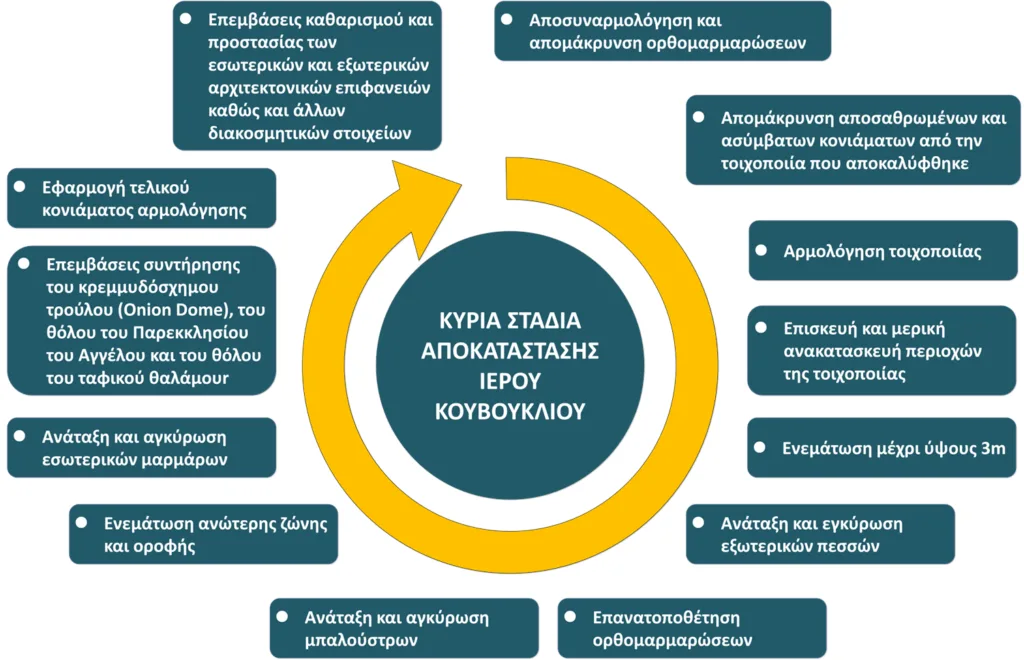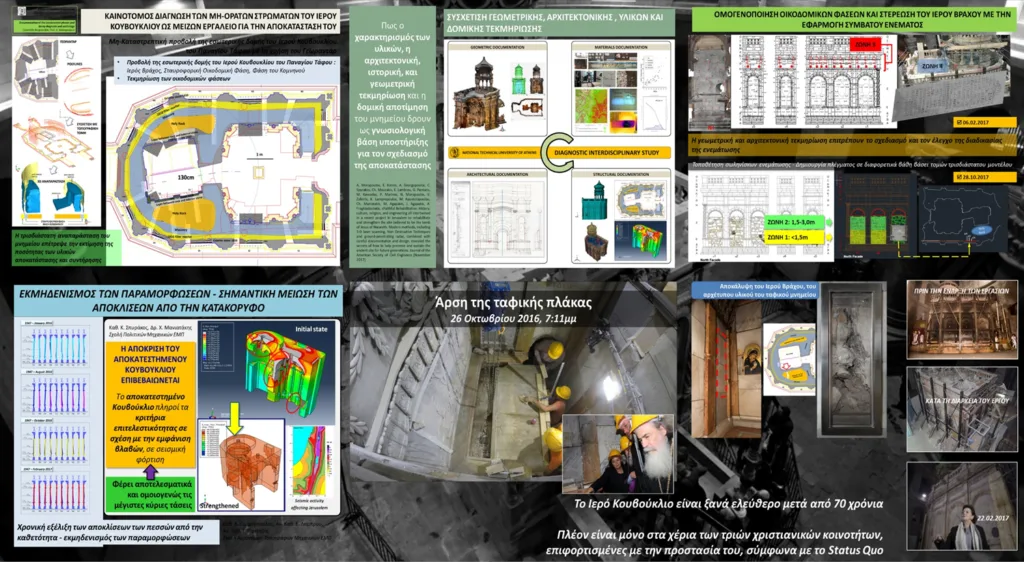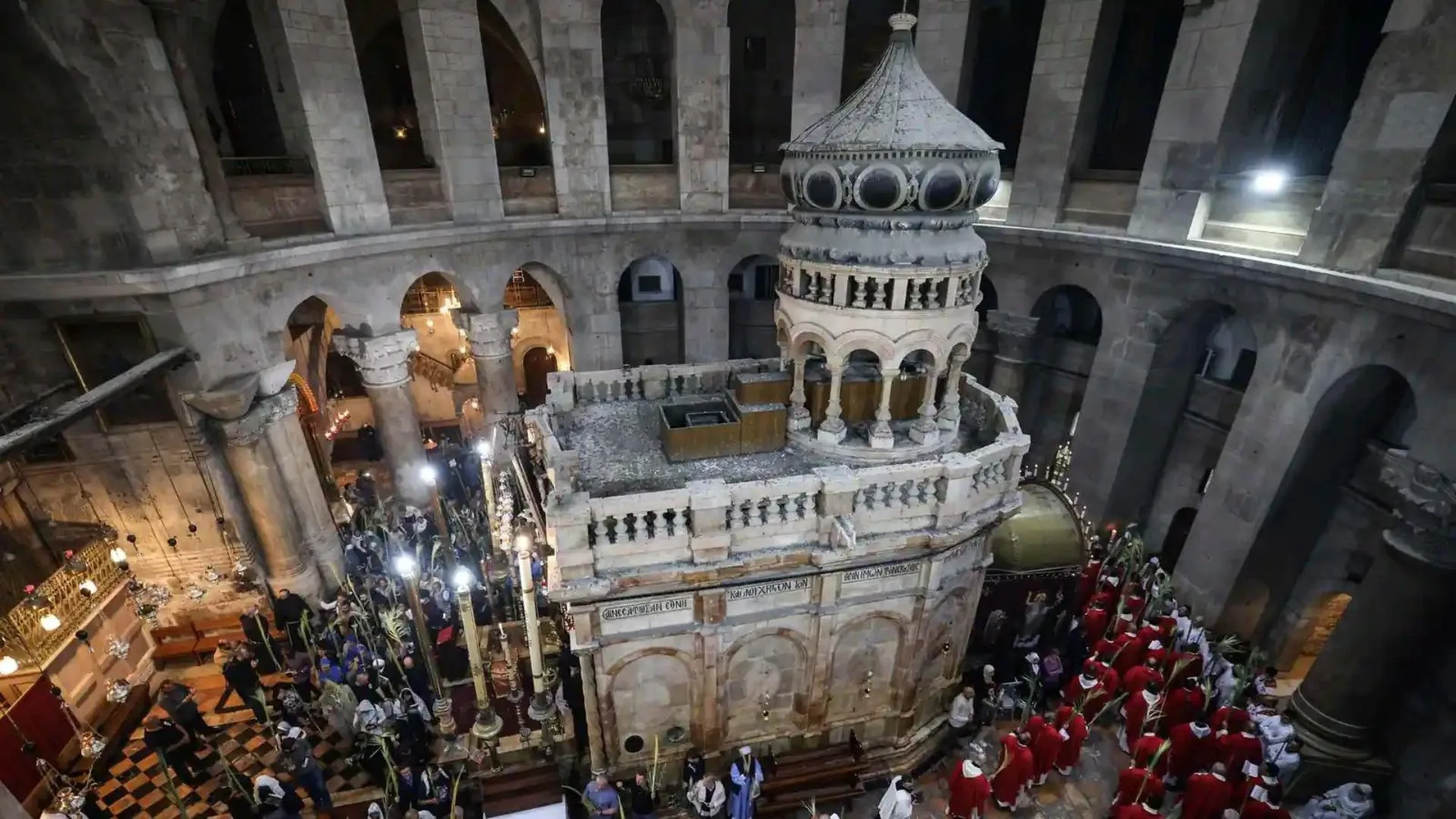By Ilias Karagiannis
It is the most emblematic monument of Christianity – The Holy Sepulchre in Jerusalem.
With Orthodox Easter just around the corner, The Greek Herald invites its readers on a journey through time via pictures, seen by some privileged people like Antonia Moropoulou, Professor Emeritus of the National Technical University of Athens (NTUA), and scientifically responsible for the restoration of the Holy Canopy.
Ms Moropoulou talks to The Greek Herald about the unique experience she lived during the process of the restoration of the Holy Sepulchre: A project that was completed in 2017, but will be in Ms Moropoulou’s memory like a tattoo. Indelibly. She even wrote a book, titled “Aspects of Applied Science and technology exploring the value landscape of Technoscience” to encapsulate the knowledge she drew from this sacred adventure.

“We saw things that no one had seen before. The Holy Sepulchre had not been opened for at least five centuries, and we are the first to use new, high measuring technologies, to be able to diagnose its history and morphology,” Ms Moropoulou says.
“The Patriarch of Jerusalem, Theophilos III, called me in March 2015, in order to examine and restore the major deformities of the Holy Canopy of the Holy Sepulchre. For this purpose, the interdisciplinary team of the National Technical University of Athens was formed by: Prof. E. Corre, School Of Architecture, Prof. P. Georgopoulos, School Of Rural Surveying Engineering, Prof. P. Moropoulou, School Of Chemical Engineering, Prof. Mr. Spyrakos, An. Prof. Allah. Mouzaki, School Of Civil Engineering.

“The diagnostic study and the restoration proposal were completed in early 2016 and presented on March 8 at the Zappeion Megaron in Athens by the National Technical University of Athens, in the presence of the heads of the three Christian communities. With geometric documentation, with three-dimensional models, with characterisation of materials, with on-site measurements, with non-destructive methods, which allowed us to see through the orthomarticulations, we diagnosed the critical state of the structural parts of the monument and formed the proposal for restoration with a sequence of compatible and performative materials and minimally intrusive interventions. Based on dialogue, the historic joint decision of the three Christian communities on March 22, 2016, allowed the project to begin, appointing the head and scientific supervisor, and assigning the NTUA multidisciplinary team the high scientific supervision.”

The Project
Ms Moropoulou settled in Jerusalem with her team to oversee the restoration.
“The construction site was set up so that pilgrims could continuously venerate the Holy Sepulchre, and Christian communities could carry out their devotional functions,” she says.

“Along with the construction site, the conservation workshop and an interdisciplinary workshop were organised in the Galleria of the Latins so that the interdisciplinary team of NTUA could support the works scientifically, evaluate them and recommend to the project management team, which combined scientific support in decision making with the management of the construction site, as well as religious and administrative management.

“The restoration of the sacred canopy took place through specific stages. When the coffers were removed, the stones were transferred to the maintenance workshop to be preserved, while, at the same time, the removal of the disintegrated mortars began at the construction site, the restoration of the masonry – up to its partial reconstruction – to proceed with the infilling with compatible grout, in order to unify the different structural phases and mainly to fix the Sacred Rock.

“When the recrosses were put back, the stones came one by one numbered and preserved from the Galleria of the Latins, mortars and concretions were added, and the sacred canopy closed. Then the dome was restored, after disinfection, with high technology and materials, fastening and maintenance, and of course restoration of its symbolic image, the one that highlighted the holes of diffusion of the Holy Light.
“The internal maintenance of both the Dome of the burial chamber and the chapel of the Angel, allowed the project to be completed internally, with parallel reconstruction of the internal pillars and connection of the orthomarticulations, while externally it was cleaned and preserved, that is, the architectural ensemble was protected and its values were highlighted. When the structural restoration was completed, its integrity was checked.
“We saw that the canopy returned to its vertical position for the first time since 1947, when the British Commission placed the iron cage. We assessed that the materials and the restoration works reinforced the earthquake-proof shielding of the sacred canopy. And then we safely removed the iron cage.”

The values that surround the sacred canopy
From the Holy Canopy, the Patriarch of Jerusalem transmits the Holy Light to all mankind.
After the interventions of Ms Moropoulou’s team, the Sacred Rock, the archetypal material of the burial monument, became visible for the first time and the “window” that will bring it close to the pilgrims will remain open forever.
“On October 26, 2016, we opened the Holy Sepulchre, after seven – others say five centuries – to protect it from grout. And it was the Holy Sepulchre which protected the whole project and us,” she says.
“The television transmission that night by National Geographic to all mankind brought to the Holy Sepulchre more than two billion, pilgrims mentally with us.
“And we, with the approval of the three primates and the entire priesthood, who anxiously watched the opening of the Holy Sepulchre, were able to take measurements and samples for the first time in history, in order to document the history and morphology of the Holy monument with non-destructive and archaeometric methods and archaeogenetics.

“Thus, we scientifically confirmed that Constantine the Great and St. Helen were the ones who erected and rectified the Holy Sepulchre. At the same time, the archaeometric investigation confirmed the historical development of the monument during the periods of Byzantium, the Crusaders, the Renaissance and the last restoration in 1810 by Kalfa Komnenos Mytilineos, and contributed with the non-destructive control and the three-dimensional documentation to the investigation of the state of preservation of the underground space and the sacred rock up to the depth of the Rotunda.
“The upper dome of the monument was also a black capstone, which today has regained its resurrected colours, while the values of the sacred Kouvoukli were restored, along with the Greek inscriptions that run through the upper frieze and which we uncovered and preserved.
“The Cross of Komnenos – “October 15, 1809 Kalfas Komnenos the Mytilineos made” – was found on the cornerstone on the southeast side of the sacred Kouvouklion and with a gold copy was crowned after photogrammetric simulation, by analogy in the monument the dome.”
Nine months of heart and soul
The work on the restoration of the monument was arduous, says Ms Moropoulou.
“Together with 70 Greek scientists, restorers, craftsmen of various specialties, we worked day and night, in two shifts a day, with our mind, with our hands, with our soul, so that in less than nine months we could deliver the Holy Canopy to the three Christian communities that entrusted it to us, but also to the whole world,” she adds.
The project could not be executed and completed:
– without the three Christian communities and especially the Greek Orthodox Patriarchate of Jerusalem that gave us this unique opportunity
– without the small and large donors from all over the world, who made the impossible possible, with the World Monuments Fund and the Great Benefactor Mika Ertegun
– without the acceptance of all religious communities in Jerusalem, whether Christian or not
– without the actual interest of the authorities of the state of Israel, but also of the Palestinian Authority, as well as the personal interest of the King of Jordan.
“At the ceremony of the handover of the Holy Canopy, on March 22, 2017, the Christian world found itself united and ecumenical, with the unstable Middle East, and with Greece united at the centre. The interdisciplinary team, with its scientific support and respect for the values of this great monument, was the one that during the dialogue with the three Christian communities, in the meetings of the management committee and in the procedures of the project itself, strengthened this unity,” she says.
“But the whole world, as it welcomed, as it commented, as it supported the work, became a bearer of the values of the Holy Sepulchre.

“The digital exhibition from National Geographic in Washington, D.C. and in collaboration with the National Technical University of Athens at the Byzantine and Christian Museum in Athens, allowed us to hare our experiences with society and made it a participant in the project.
“The project is over. The investigation continues. Scientists, historians, archaeologists, theologians, sociologists, all over the world based on the data of the project will have a lot to say in the future about the values and history of the monument. But we have demonstrated these values and confirmed them scientifically.”
